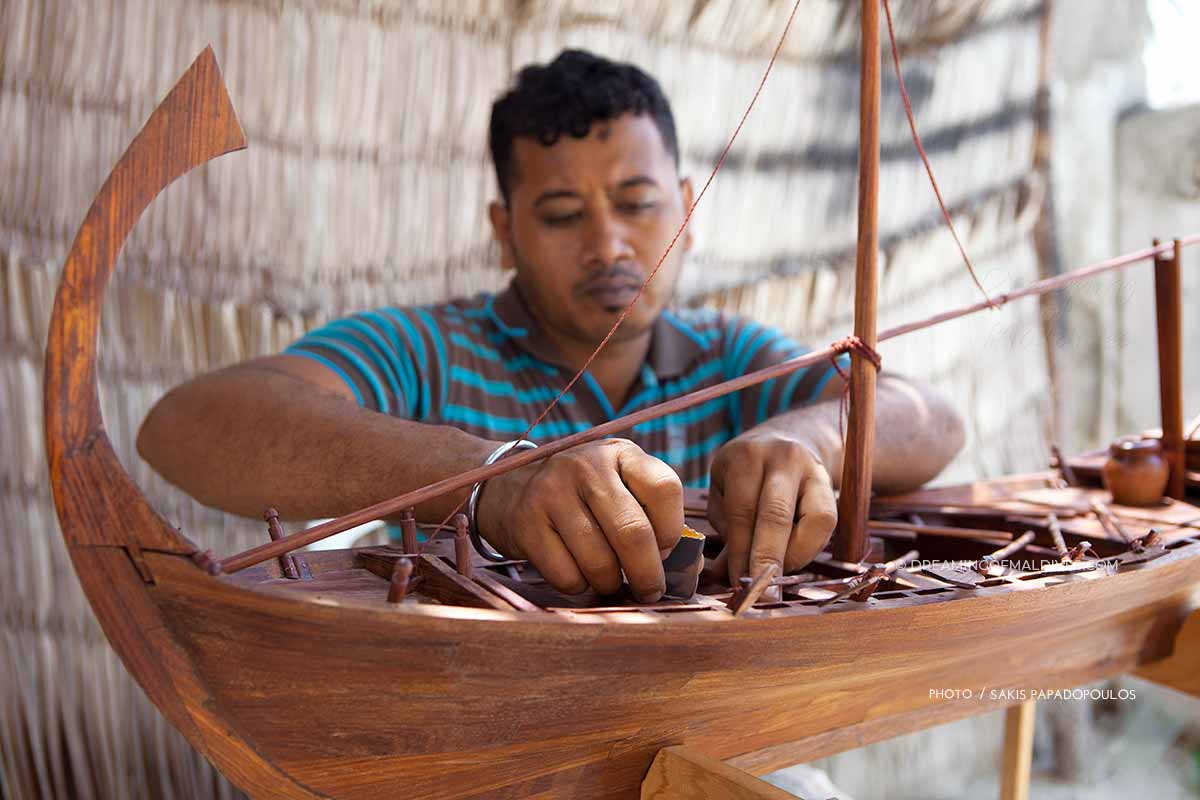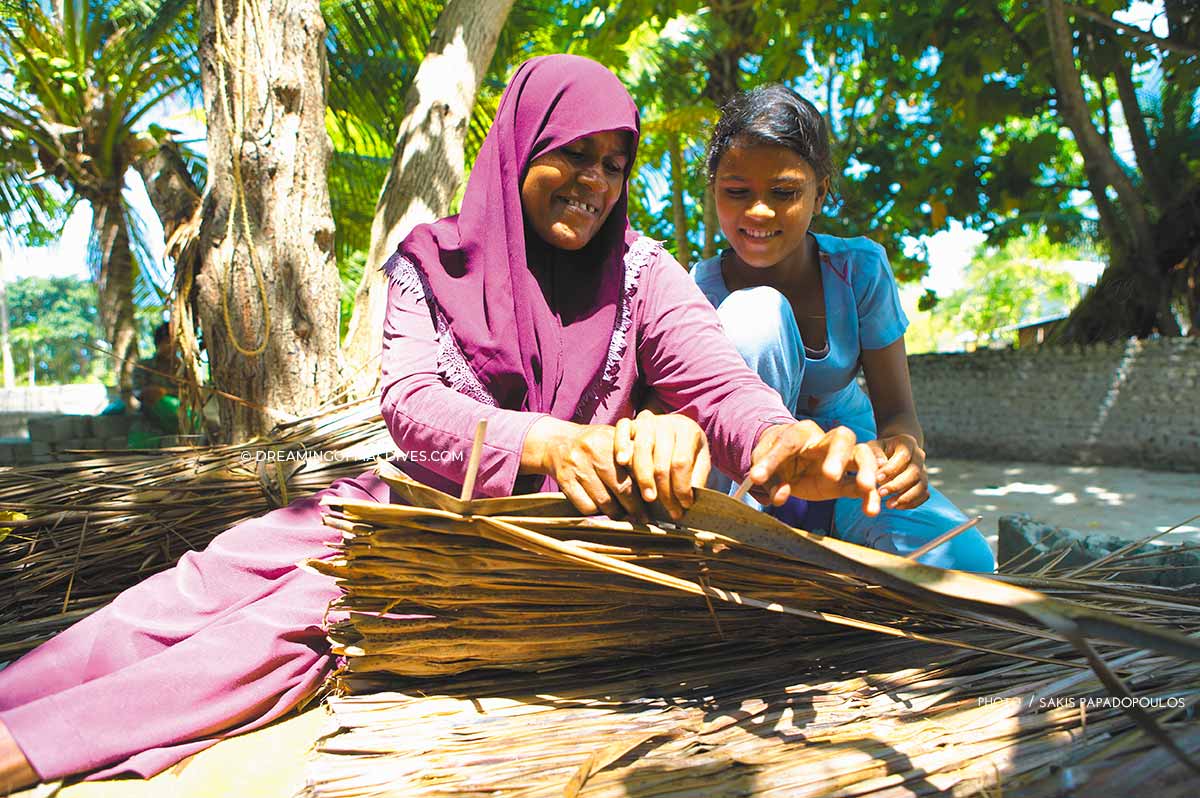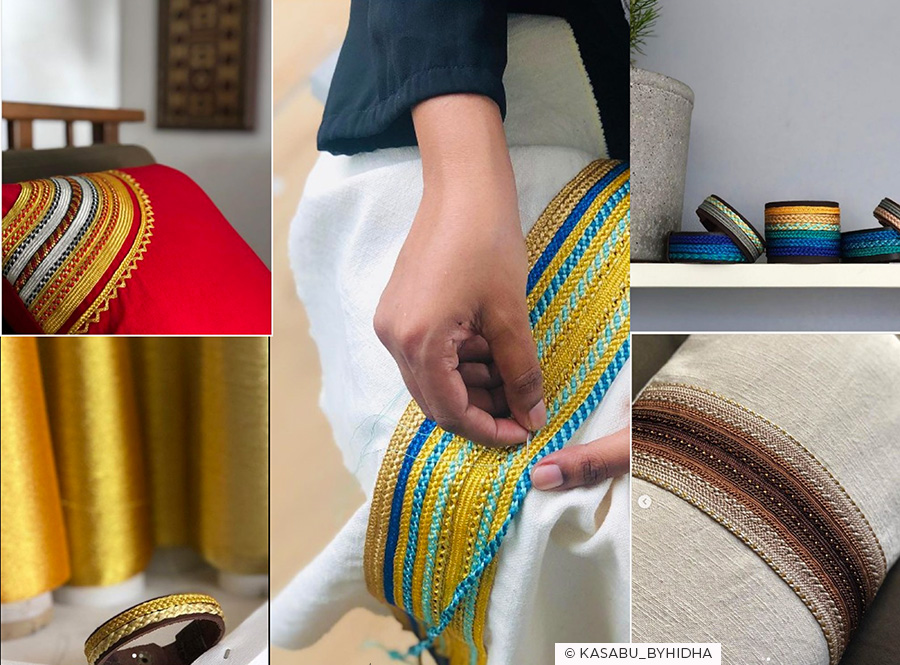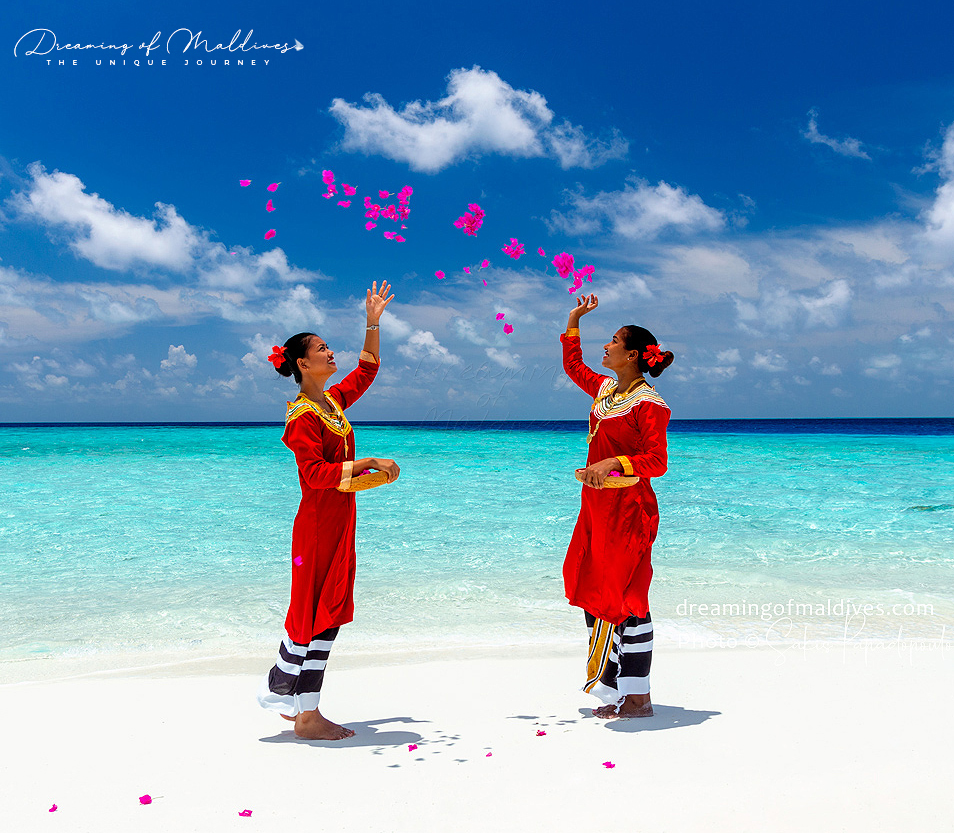In the Maldives culture, the Dhivehi Libaas is the traditional dress worn by women for ceremonies, special occasions and dances.
Unique to the Maldives, these brightly colored dresses are adorned with intricate gold and silver embroidery, still crafted by a few Maldivian women around the archipelago.
If you go to the Maldives, you will probably see a Maldivian lady wearing a Dhiveli Libaas, so you better know their beautiful story and long craftsmanship behind these garments.

The Dhivehi Libaas or literally the Maldives Dress
Dhiveli Libaas , which literally means Maldives ( – Dhivehi ) and Dress ( – Libaas ) is a long-sleeved, brightly red-colored dress, worn above a black and white stripped sarong called feyli.

Feyli.
The Maldivian Sarong
A feyli, the typical black and white stripped Maldivian sarong here worn by a Bodu Beru Drummer.
These traditional dresses are widely worn during ceremonial occasions and dance performances around the Maldives.
Here, a Maldivian lady wearing the Dhivehi Libaas during a Bodu Beru performance.

A Dhivehi Libaas with full embroidery takes a minimum of 2 weeks to be created.
Dhivehi Libaas and the delicate art of fine embroidery
Besides being red, the Dhivehi Libaas immediately strikes the eyes with its large embroidered collar made from gold and silver threads, cotton and silk. Some dresses also have these embroideries at the extremity of their sleeves.
Called Kasabu boavalhu in Dhivehi, these embroideries are still crafted by the delicate hands of some talented women around the Maldives and take a minimum of 2 weeks to be created.
The Libaas is generally worn with a golden necklace called the Fattaru Bae, a traditional Maldivian jewellery.

Maldives traditional crafts are unfortunately dying out with increased modernization and industrialization ( this phenomenon is worldwide and not only in the Maldives…). However these embroideries are still crafted on some local islands and by a few young designers ( see further down to discover Hidha’s Kasabu artwork !).
The red libaas is still made on demand by a few tailor shops in Male, the capital city.

the people.
Maldivians are proud islanders but remain the discreet guardians of their cultural heritage.
If not obvious to the traveler, their customs and traditions are more rich than it appears.
Go travel around the Maldives and visit local islands, you will surely see some traditional crafts made in local houses.
Maldivians are the discreet guardians of their cultural heritage.
Photo © Sakis / Dreaming of Maldives
The Dhivehi Libaas is now mostly seen in resorts, during wedding ceremonies, special events, or in cultural performances to showcase the Maldivian heritage to tourists. Some ladies from the resort will wear these beautiful red dresses for the occasion.
But generally, in everyday life, the garment has become less common.
However, you might still see this dree worn by elderly women on some local islands, especially in far communities, or during some official ceremonies in Male, the capital.
Here, two women wearing the Libaas during a wedding ceremony organized for tourists in a resort.

The Dhivehi Libaas. A fading Craft
A few people still know how to weave the libaas. This weaving technique is a complex and time-consuming process that involves traditional looms and natural materials and primarily cotton.
Traditionally made in Baa Atoll, once the main source for feyli‘s ( the cotton fabrics used in traditional Maldivian garments), this method of production has slowly been replaced by synthetic fabrics and polyester prints, which are easier and cheaper to produce, maintain and wash.
As a result, the knowledge and skills required for this craft are at risk of being lost, with only a few artisans still practicing it today. Efforts are being made to preserve this important cultural heritage, but the transition to easier and cheaper techniques has undeniably impacted the knowledge of this craft in the Maldives.
Read more about Maldives Culture
The Dhivehi Libaas is such an important component of Maldivian lives that they illustrate one Maldivian currency bill of 100 rufiyaa.


the Culture.
Maldives culture has evolved with the times. Locals still eat fish and fishermen still spend days out at sea, but tourism now prevails.
The influence of modern world has spread on many local islands where people try to save and preserve their culture and traditions.
Some Maldivians strive to preserve their culture and traditions.
Photo © Sakis / Dreaming of Maldives
Hereunder this young Maldivian lady is smoking the shisha in a joali, the typical Maldivian chair. Under her red libaas, we can see her black and white feyli.

The art of Kasabu boavalhu
The art of Kasabu boavalhu is a long process and requires time and meticulousness like all type of fine embroidery.
Despite its industrialization, the technique and the design might have a recent revival with the love and dedication of some young Maldivian designers and artisans who keep it alive and apply it to new items.
I recently found a Maldivian lady called Hidha who not only preserves the Kasabu for the Libaas but also creates beautiful accessories like wristbands, pillows or framed Kasabu artwork.
Some of Hidha’s handmade creations

Hidha organizes Kasabu classes on local islands and teach other Maldivian woman to master it as a way to share her love for it and to make sure that the technique remains.
On her Instagram account, Hidha shows her work and explains us how the Kasabu is made.
The embroidery
The embroidery is composed of several “Rodhigandu “, a braid weaved using cotton/silk thread and metallic ribbon (baadhala) which are then placed in the middle of “Kasabu Boavalhu”.
Hereunder she posts where it’s made :
I really invite you to discover more of Hidha’s work on her instagram account here : https://www.instagram.com/kasabu_byhidha/

read more /
Maldives Traditions, History and Culture
Insider’s Guide to Maldives Culture
A Photo Tribute to The Dhoni, The Maldivian Traditional Boat
Maldives Traditional Music – The Bodu Beru. At the Heart of Maldives Music Soul
At the heart of Maldives History : welcome to Utheemu, Northern Maldives
Follow us on Facebook, Youtube and Instagram
for more Maldives Dreams & Stories
[ Official ]
Traveler's Choice
14th Edition


























